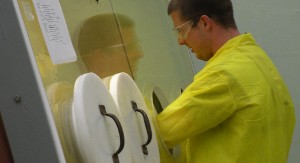The chemical element actinium is classed as an actinide metal. It was discovered in 1899 by Andre Debierne.

Data Zone
| Classification: | actinide metal |
| Color: | silvery-white |
| Atomic weight: | (227), no stable isotopes |
| State: | solid |
| Melting point: | 1050 oC, 1323 K |
| Boiling point: | 3199 oC, 3471 K |
| Electrons: | 89 |
| Protons: | 89 |
| Neutrons in most abundant isotope: | 138 |
| Electron shells: | 2,8,18,32,18,9,2 |
| Electron configuration: | [Rn] 6d1 7s2 |
| Density @ 20oC: | 10.07 g/cm3 |
Compounds, Radii, Conductivities
| Atomic volume: | 22.54 cm3/mol |
| Structure: | fcc: face-centered cubic |
| Hardness: | mohs |
| Specific heat capacity | 27.2 J mol-1 K-1 |
| Heat of fusion | 14.2 kJ mol-1 |
| Heat of atomization | 406 kJ mol-1 |
| Heat of vaporization | 400 kJ mol-1 |
| 1st ionization energy | 499 kJ mol-1 |
| 2nd ionization energy | 1170 kJ mol-1 |
| 3rd ionization energy | – |
| Electron affinity | – |
| Minimum oxidation number | 0 |
| Min. common oxidation no. | 0 |
| Maximum oxidation number | 3 |
| Max. common oxidation no. | 3 |
| Electronegativity (Pauling Scale) | 1.1 |
| Polarizability volume | 32.1 Å3 |
| Reaction with air | mild, w/ht, ⇒ Ac2O3 |
| Reaction with 15 M HNO3 | mild, ⇒ Ac(NO3)3 |
| Reaction with 6 M HCl | mild, ⇒ H2, AcCl3 |
| Reaction with 6 M NaOH | – |
| Oxide(s) | Ac2O3 |
| Hydride(s) | AcH2 |
| Chloride(s) | AcCl3 |
| Atomic radius | 195 pm |
| Ionic radius (1+ ion) | – |
| Ionic radius (2+ ion) | – |
| Ionic radius (3+ ion) | 112 pm |
| Ionic radius (1- ion) | – |
| Ionic radius (2- ion) | – |
| Ionic radius (3- ion) | – |
| Thermal conductivity | – |
| Electrical conductivity | – |
| Electrical conductivity | – |
| Freezing/Melting point: | 1050 oC, 1323 K |

Actinium is radioactive. Image Ref.(1)
Discovery of Actinium
The radioactive element actinium was discovered by Andre Debierne in 1899, in Paris, France.
Debierne worked with Marie Curie and discovered actinium in pitchblende (uranium ore) from which radium and polonium had already been extracted.
He was able to identify the presence of a new element because the radioactive emissions profile of his sample could not be explained by the presence of any known element.
Debierne was unable to isolate pure actinium from the thorium also present in pitchblende.
Appearance and Characteristics
Harmful effects:
Actinium is highly radioactive.
Characteristics:
Actinium is radioactive; it glows in the dark
Uses of Actinium
Actinium is used as a source of neutrons.
Abundance and Isotopes
Abundance Earth’s Crust: 0.0005 parts per trillion by weight
Abundance Solar System: negligible
Cost, pure: $ per 100g
Cost, bulk: $ per 100g
Source: Natural U-235 radioactive decay. A ton of pitcheblende contains about 0.15 milligrams of actinium. Nowadays, actinium is generally produced by the neutron irradiation of 226Ra.
Isotopes: Actinium has 29 isotopes. All are radioactive. 227Ac occurs naturally in uranium ore and, at 21.773 years, has the longest Ac half-life.

References
- Photo by ORNL.
Cite this Page
For online linking, please copy and paste one of the following:
<a href="https://www.chemicool.com/elements/actinium.html">Actinium</a>
or
<a href="https://www.chemicool.com/elements/actinium.html">Actinium Element Facts</a>
To cite this page in an academic document, please use the following MLA compliant citation:
"Actinium." Chemicool Periodic Table. Chemicool.com. 07 Oct. 2012. Web. <https://www.chemicool.com/elements/actinium.html>.